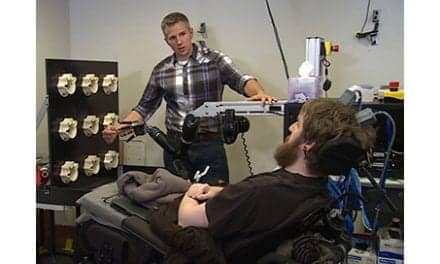It all started with Quality Assurance…
Then came Utilization Review…
Now there is Corporate Compliance
 |
| Nancy J. Beckley, MS, MBA, CHC, is certified in Healthcare Compliance and is president of Bloomingdale Consulting Group Inc. Comments and questions are encouraged; please go to www.BloomingdaleConsulting.com, or call (888) 999-0275. |
According to Wikipedia, the online open source encyclopedia, “Umbrella insurance refers to an insurance policy that protects the assets and future income of the policyholder above and beyond the standard limits set on their primary policies.” For example, a family might have a homeowner’s policy and auto policy, a boat policy, a motorcycle policy, and so forth. An insurance agent in these situations often recommends an umbrella policy that provides coverage over and above the listed individual policies to protect the homeowner.
A good compliance plan is just that, an umbrella policy for the rehab provider—an umbrella policy that sits on top of clinical policies and procedures, financial policies and procedures, HR policies and procedures, as well as administrative, operational, and regulatory policies and procedures. Many rehab providers tend to look at the development of a compliance plan as something that might not be necessary for a small clinic, something perhaps that is necessary only for very large rehab providers, or hospital-based rehab providers.
QUALITY
The quality assurance movement is not unique to health care; in fact, it started in the manufacturing arena. Component examples are threaded throughout health care. For example, The Joint Commission has quality standards, CARF (Commission on Accreditation of Rehabilitation Facilities) has quality standards, as do most other accreditation bodies within the health care industry. At a minimum, all health care providers profess to have a program based on quality, and there is a minimum expectation on the part of consumers that health care providers do strive for quality. Consumers see this as the “Good Housekeeping Seal of Approval.”
For rehab providers, the profession of a “quality program” often starts with their mission statement; in fact, most rehab mission statements declare the provider to be the “pre-eminent” provider, offering the “highest quality” or “state of the art” services. Come to think of it, I have never seen a rehab mission statement positioning a rehab provider to be “average” or even “low cost,” as in health care low cost might be inadvertently construed as “low quality.”
According to CARF, “CARF-accredited service providers meet the highest national and international standards for quality, such as employing qualified professional staff. CARF accreditation demonstrates quality on a more personal level—your seal of satisfaction.”
CARF contends that quality rehab providers exhibit the following characteristics:
- The organization asks you, the customer, if you are satisfied with your services. The organization believes that only the customer can evaluate quality.
- Service planning is done by teams that include you and design your plan to meet your unique needs and preferences.
- The organization is responsive to your questions about your plan and services, and it makes sure that you have and understand the information you need.
- Service plans are individualized to meet your needs as a unique person.
- The mission and purpose of the organization reflect an attitude of “The customer is always right and should be delighted by the services provided and the service provider.” (Source: carf.org )
In order to demonstrate commitment to quality, rehab providers have policies and procedures that define the quality-related activities, for example, a policy that indicates treatment plans are individualized, or a policy that describes the provider’s patient satisfaction survey. And, of course, a top-quality rehab provider will compile and analyze the results of the patient satisfaction surveys, and make program adjustments as necessary.
The CMS Physician Quality Reporting Initiative (PQRI) was initially implemented in 2007 with only one quality measure that physical and occupational therapists could report on: Screening for Future Fall Risk. In 2008, that number was increased to eight, with the addition of seven new measures: Adoption/Use of Health IT; Diabetic Foot/Ankle Care Footwear Evaluation; Diabetic Foot/Ankle Care Neurological Evaluation; Documentation & Verification of Medications; Pain Assessment Prior to Therapy; Patient Co-Development of Plan of Care; and Universal Weight Screening & Follow-Up. Therapists reporting on these quality measures are eligible to receive a bonus payment (which in 2009 is at 2%, up from 1.5% in 2008). The fact sheet for each measure indicates the anticipated health benefits and provides background rationale statements for the measure as well as clinical recommendation statements.
UTILIZATION REVIEW
Utilization review is a backward review of health care after it has been delivered and documented. Many rehab providers who work with managed care plans that require preapproval for therapy visits are familiar with the term “utilization management,” which is a prospective look at the appropriateness of services that are proposed for patients. When rehab providers are reviewing charts of concurrent patients, as well as discharged patients, they are often looking to ensure that all documentation elements are present.
Many rehab providers do this as a routine with Medicare patient charts in order to ensure that Medicare requirements, such as physician certification of the plan of care, are met. On this type of chart review, it is very easy to check for objective elements. For example, is a physician signature on the plan of care, was a daily treatment note done for each day of therapy, was a progress note written every 30 days or 10 visits? Objective elements are easy to check off on a list as either met or not met. It is the subjective elements that are harder to assess: was skilled care present, or was the therapy medically necessary. When an insurance company or Medicare performs a utilization review, the results of the subjective areas of review may differ from the results of your clinic’s chart review program findings. The Conditions of Participation for a Rehab Agency specify that a rehab agency’s clinical record committee will review, on a quarterly basis, a sample of active and closed clinical records, to ensure that the organization’s policies are being followed. Interesting to note, the review is required to list corrective actions taken if the organization finds that polices and procedures are not being followed.
As we have taken a look at some quality assurance activities as well as utilization review activities, it is not a far stretch to see that an effective compliance program, even for a small therapy practice, is an essential element in today’s practice environment.
An effective compliance program acts as an umbrella policy, sitting on top of your clinic’s other policies and procedures to provide extra protection. The Office of Inspector General (OIG) lists seven elements of an effective compliance program in its guidance for physicians and small providers issued in 2000:
- Conducting internal monitoring and auditing through the performance of periodic audits;
- Implementing compliance and practice standards through the development of written standards and procedures;
- Designating a compliance officer/contact to monitor compliance efforts and enforce practice standards;
- Conducting effective training and education on practice standards and procedures;
- Responding appropriately to detected violations through the investigation of allegations and the disclosure of incidents to appropriate government entities;
- Effective lines of communication to address compliance issues, such as staff meetings and community bulletin boards;
- Enforcing clear disciplinary standards for violations through well-publicized guidelines.
The compliance guidance itself suggests that it does not anticipate that every element will be implemented by small practices, which represents a change of course from the compliance guidances issued for hospitals, skilled facilities, and other large providers.
Take a look at the above seven elements:
- It is entirely likely that you are performing periodic monitoring and auditing through quality assurance and utilization review activities.
- Review your policies and procedures; it might not take as much effort as you think to layer in the compliance-related policies necessary.
- You don’t have to name a compliance office, as a large hospital would, but you can designate a compliance committee. If you are a rehab agency, that compliance committee can be your clinical record committee.
- Rehab facilities are used to providing provider education and CEU activities; it’s natural to add compliance as one of your training efforts using the structure you already have in place.
- As a rehab provider, you are probably already addressing concerns and complaints from staff and patients alike, as infrequent as they may be. Formalize this process by publishing contact information (such as you have already done to be HIPAA compliant) and formalize the process in your procedures.
- In your regularly scheduled staff and committee meetings, take the opportunity to have compliance on the agenda, and post your commitment to quality and compliance in your waiting room, ensuring that patients do have a point of contact to address concerns. (Better to call you than the OIG.)
- When a compliance breach is noted, follow your established disciplinary procedures. For example, if your facility uses a progressive discipline plan, you would follow that same plan for compliance breaches. If you note that a therapist is never documenting minutes for a Medicare patient, the first disciplinary action might call for a verbal warning, while a second incidence of noncompliance would call for a written warning and so forth. (Keep in mind that certain activities of noncompliance may call for providers to refund Medicare as well as other payors.)
Grab your umbrella, it’s rainy season, and the OIG has targeted for review this year private practice physical therapists. Open that umbrella, and shield yourself from the storm!




